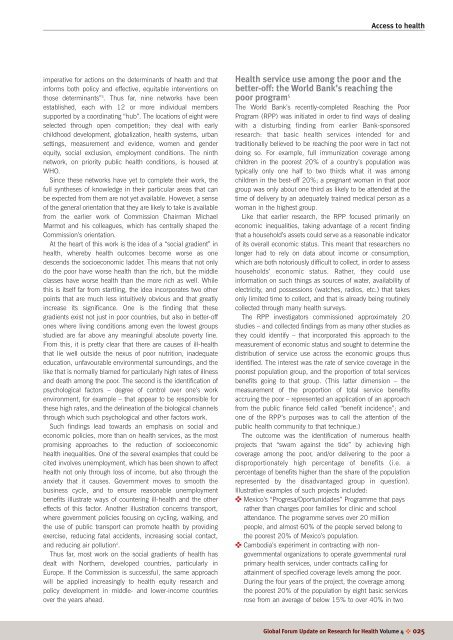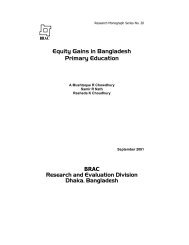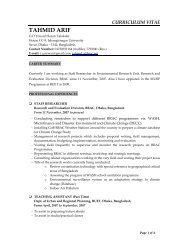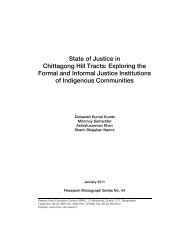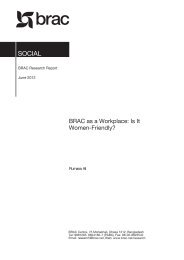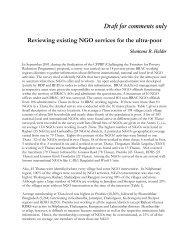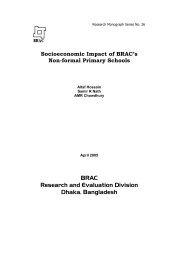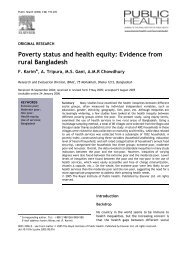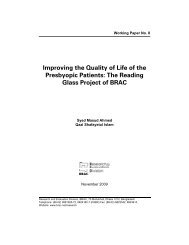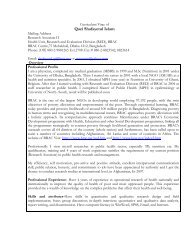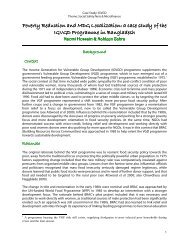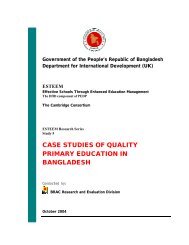Combining health and social protection measures to reach the ultra ...
Combining health and social protection measures to reach the ultra ...
Combining health and social protection measures to reach the ultra ...
Create successful ePaper yourself
Turn your PDF publications into a flip-book with our unique Google optimized e-Paper software.
Access <strong>to</strong> <strong>health</strong><br />
imperative for actions on <strong>the</strong> determinants of <strong>health</strong> <strong>and</strong> that<br />
informs both policy <strong>and</strong> effective, equitable interventions on<br />
those determinants” 3 . Thus far, nine networks have been<br />
established, each with 12 or more individual members<br />
supported by a coordinating “hub”. The locations of eight were<br />
selected through open competition; <strong>the</strong>y deal with early<br />
childhood development, globalization, <strong>health</strong> systems, urban<br />
settings, measurement <strong>and</strong> evidence, women <strong>and</strong> gender<br />
equity, <strong>social</strong> exclusion, employment conditions. The ninth<br />
network, on priority public <strong>health</strong> conditions, is housed at<br />
WHO.<br />
Since <strong>the</strong>se networks have yet <strong>to</strong> complete <strong>the</strong>ir work, <strong>the</strong><br />
full syn<strong>the</strong>ses of knowledge in <strong>the</strong>ir particular areas that can<br />
be expected from <strong>the</strong>m are not yet available. However, a sense<br />
of <strong>the</strong> general orientation that <strong>the</strong>y are likely <strong>to</strong> take is available<br />
from <strong>the</strong> earlier work of Commission Chairman Michael<br />
Marmot <strong>and</strong> his colleagues, which has centrally shaped <strong>the</strong><br />
Commission’s orientation.<br />
At <strong>the</strong> heart of this work is <strong>the</strong> idea of a “<strong>social</strong> gradient” in<br />
<strong>health</strong>, whereby <strong>health</strong> outcomes become worse as one<br />
descends <strong>the</strong> socioeconomic ladder. This means that not only<br />
do <strong>the</strong> poor have worse <strong>health</strong> than <strong>the</strong> rich, but <strong>the</strong> middle<br />
classes have worse <strong>health</strong> than <strong>the</strong> more rich as well. While<br />
this is itself far from startling, <strong>the</strong> idea incorporates two o<strong>the</strong>r<br />
points that are much less intuitively obvious <strong>and</strong> that greatly<br />
increase its significance. One is <strong>the</strong> finding that <strong>the</strong>se<br />
gradients exist not just in poor countries, but also in better-off<br />
ones where living conditions among even <strong>the</strong> lowest groups<br />
studied are far above any meaningful absolute poverty line.<br />
From this, it is pretty clear that <strong>the</strong>re are causes of ill-<strong>health</strong><br />
that lie well outside <strong>the</strong> nexus of poor nutrition, inadequate<br />
education, unfavourable environmental surroundings, <strong>and</strong> <strong>the</strong><br />
like that is normally blamed for particularly high rates of illness<br />
<strong>and</strong> death among <strong>the</strong> poor. The second is <strong>the</strong> identification of<br />
psychological fac<strong>to</strong>rs – degree of control over one’s work<br />
environment, for example – that appear <strong>to</strong> be responsible for<br />
<strong>the</strong>se high rates, <strong>and</strong> <strong>the</strong> delineation of <strong>the</strong> biological channels<br />
through which such psychological <strong>and</strong> o<strong>the</strong>r fac<strong>to</strong>rs work.<br />
Such findings lead <strong>to</strong>wards an emphasis on <strong>social</strong> <strong>and</strong><br />
economic policies, more than on <strong>health</strong> services, as <strong>the</strong> most<br />
promising approaches <strong>to</strong> <strong>the</strong> reduction of socioeconomic<br />
<strong>health</strong> inequalities. One of <strong>the</strong> several examples that could be<br />
cited involves unemployment, which has been shown <strong>to</strong> affect<br />
<strong>health</strong> not only through loss of income, but also through <strong>the</strong><br />
anxiety that it causes. Government moves <strong>to</strong> smooth <strong>the</strong><br />
business cycle, <strong>and</strong> <strong>to</strong> ensure reasonable unemployment<br />
benefits illustrate ways of countering ill-<strong>health</strong> <strong>and</strong> <strong>the</strong> o<strong>the</strong>r<br />
effects of this fac<strong>to</strong>r. Ano<strong>the</strong>r illustration concerns transport,<br />
where government policies focusing on cycling, walking, <strong>and</strong><br />
<strong>the</strong> use of public transport can promote <strong>health</strong> by providing<br />
exercise, reducing fatal accidents, increasing <strong>social</strong> contact,<br />
<strong>and</strong> reducing air pollution 4 .<br />
Thus far, most work on <strong>the</strong> <strong>social</strong> gradients of <strong>health</strong> has<br />
dealt with Nor<strong>the</strong>rn, developed countries, particularly in<br />
Europe. If <strong>the</strong> Commission is successful, <strong>the</strong> same approach<br />
will be applied increasingly <strong>to</strong> <strong>health</strong> equity research <strong>and</strong><br />
policy development in middle- <strong>and</strong> lower-income countries<br />
over <strong>the</strong> years ahead.<br />
Health service use among <strong>the</strong> poor <strong>and</strong> <strong>the</strong><br />
better-off: <strong>the</strong> World Bank’s <strong>reach</strong>ing <strong>the</strong><br />
poor program 5<br />
The World Bank’s recently-completed Reaching <strong>the</strong> Poor<br />
Program (RPP) was initiated in order <strong>to</strong> find ways of dealing<br />
with a disturbing finding from earlier Bank-sponsored<br />
research: that basic <strong>health</strong> services intended for <strong>and</strong><br />
traditionally believed <strong>to</strong> be <strong>reach</strong>ing <strong>the</strong> poor were in fact not<br />
doing so. For example, full immunization coverage among<br />
children in <strong>the</strong> poorest 20% of a country’s population was<br />
typically only one half <strong>to</strong> two thirds what it was among<br />
children in <strong>the</strong> best-off 20%; a pregnant woman in that poor<br />
group was only about one third as likely <strong>to</strong> be attended at <strong>the</strong><br />
time of delivery by an adequately trained medical person as a<br />
woman in <strong>the</strong> highest group.<br />
Like that earlier research, <strong>the</strong> RPP focused primarily on<br />
economic inequalities, taking advantage of a recent finding<br />
that a household’s assets could serve as a reasonable indica<strong>to</strong>r<br />
of its overall economic status. This meant that researchers no<br />
longer had <strong>to</strong> rely on data about income or consumption,<br />
which are both no<strong>to</strong>riously difficult <strong>to</strong> collect, in order <strong>to</strong> assess<br />
households’ economic status. Ra<strong>the</strong>r, <strong>the</strong>y could use<br />
information on such things as sources of water, availability of<br />
electricity, <strong>and</strong> possessions (watches, radios, etc.) that takes<br />
only limited time <strong>to</strong> collect, <strong>and</strong> that is already being routinely<br />
collected through many <strong>health</strong> surveys.<br />
The RPP investiga<strong>to</strong>rs commissioned approximately 20<br />
studies – <strong>and</strong> collected findings from as many o<strong>the</strong>r studies as<br />
<strong>the</strong>y could identify – that incorporated this approach <strong>to</strong> <strong>the</strong><br />
measurement of economic status <strong>and</strong> sought <strong>to</strong> determine <strong>the</strong><br />
distribution of service use across <strong>the</strong> economic groups thus<br />
identified. The interest was <strong>the</strong> rate of service coverage in <strong>the</strong><br />
poorest population group, <strong>and</strong> <strong>the</strong> proportion of <strong>to</strong>tal services<br />
benefits going <strong>to</strong> that group. (This latter dimension – <strong>the</strong><br />
measurement of <strong>the</strong> proportion of <strong>to</strong>tal service benefits<br />
accruing <strong>the</strong> poor – represented an application of an approach<br />
from <strong>the</strong> public finance field called “benefit incidence”; <strong>and</strong><br />
one of <strong>the</strong> RPP’s purposes was <strong>to</strong> call <strong>the</strong> attention of <strong>the</strong><br />
public <strong>health</strong> community <strong>to</strong> that technique.)<br />
The outcome was <strong>the</strong> identification of numerous <strong>health</strong><br />
projects that “swam against <strong>the</strong> tide” by achieving high<br />
coverage among <strong>the</strong> poor, <strong>and</strong>/or delivering <strong>to</strong> <strong>the</strong> poor a<br />
disproportionately high percentage of benefits (i.e. a<br />
percentage of benefits higher than <strong>the</strong> share of <strong>the</strong> population<br />
represented by <strong>the</strong> disadvantaged group in question).<br />
Illustrative examples of such projects included:<br />
✜ Mexico’s “Progresa/Oportunidades” Programme that pays<br />
ra<strong>the</strong>r than charges poor families for clinic <strong>and</strong> school<br />
attendance. The programme serves over 20 million<br />
people, <strong>and</strong> almost 60% of <strong>the</strong> people served belong <strong>to</strong><br />
<strong>the</strong> poorest 20% of Mexico’s population.<br />
✜ Cambodia’s experiment in contracting with nongovernmental<br />
organizations <strong>to</strong> operate governmental rural<br />
primary <strong>health</strong> services, under contracts calling for<br />
attainment of specified coverage levels among <strong>the</strong> poor.<br />
During <strong>the</strong> four years of <strong>the</strong> project, <strong>the</strong> coverage among<br />
<strong>the</strong> poorest 20% of <strong>the</strong> population by eight basic services<br />
rose from an average of below 15% <strong>to</strong> over 40% in two<br />
Global Forum Update on Research for Health Volume 4 ✜ 025


